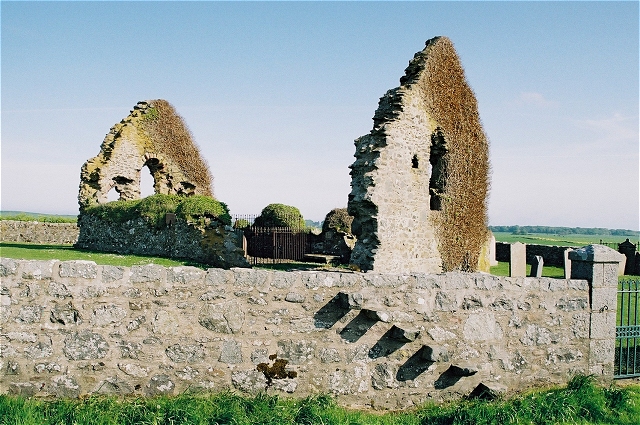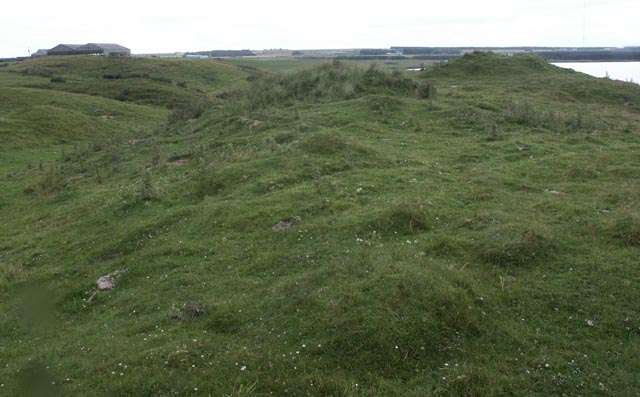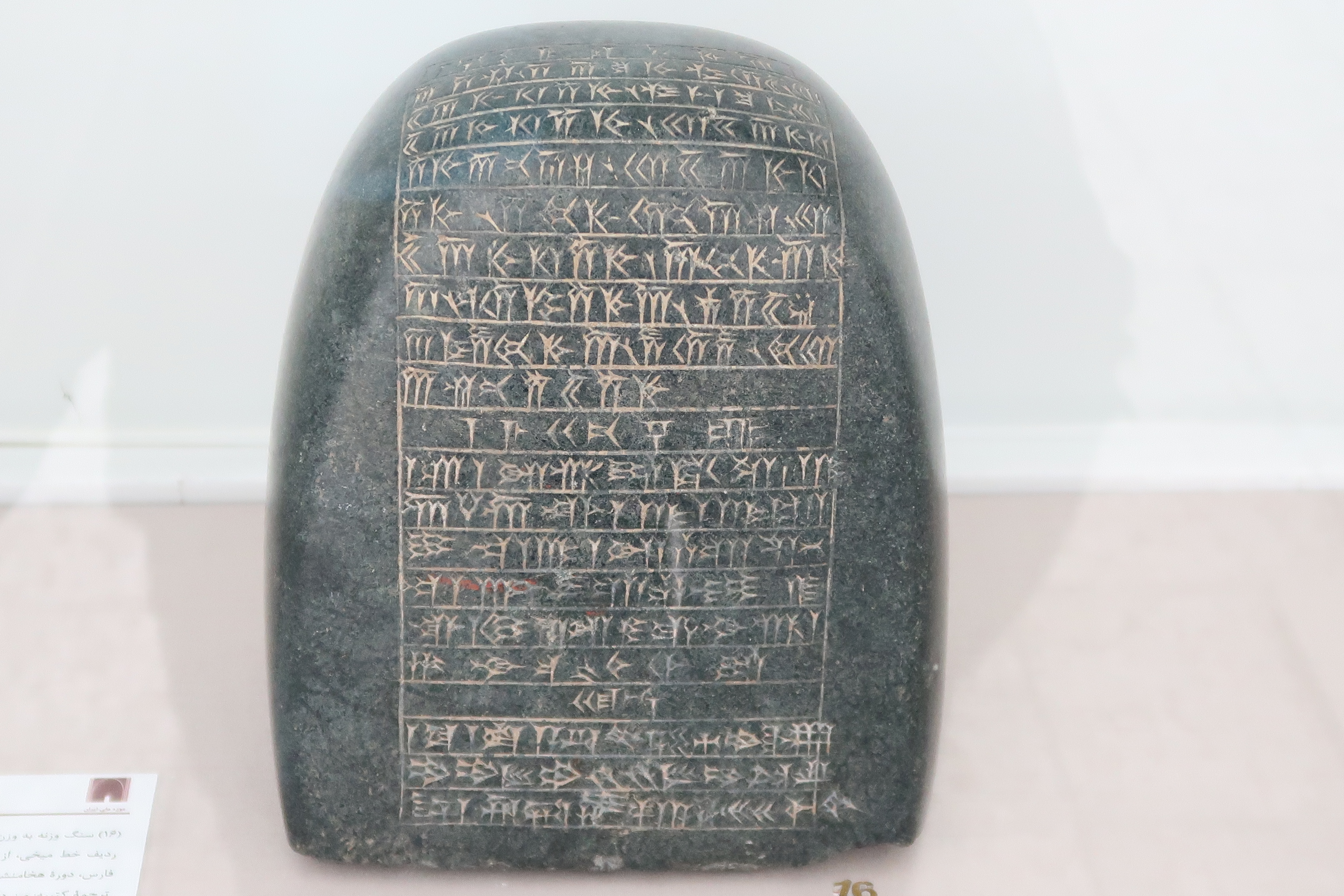|
St Mary's Chapel, Rattray
St Mary's Chapel (known also as "the Chapel of the Blessed Virgin") is a late 12th/early 13th century chapel found in Rattray, Aberdeenshire, Scotland. It was built by William Comyn, jure uxoris Earl of Buchan during the same period as the Castle of Rattray and was ''"private chapel for the castle"'' and its residents. ''"Dedicated to the Virgin Mary"'' it was possibly constructed after the ''"drowning of a"...'' nknown''"son of Comyn in the well near by."'' There is some controversy as to the date of the chapel's construction. There is a wall plaque with the date 911, but this is certainly a fake as the style of the church and its windows did not appear in Scotland until the late 12th century, which coincides with an account that states it ''"probably dates back to the late 1100s."'' William Comyn did not inherit the Earldom of Buchan until 1212, so the chapel's construction almost certainly did not begin prior to this date. William Comyn is recorded as giving the chapel ''"a ... [...More Info...] [...Related Items...] OR: [Wikipedia] [Google] [Baidu] |
Chapel
A chapel (from , a diminutive of ''cappa'', meaning "little cape") is a Christianity, Christian place of prayer and worship that is usually relatively small. The term has several meanings. First, smaller spaces inside a church that have their own altar are often called chapels; the Lady chapel is a common type of these. Second, a chapel is a place of worship, sometimes Interfaith worship spaces, interfaith, that is part of a building, complex, or vessel with some other main purpose, such as a school, college, hospital, palace or large aristocratic house, castle, barracks, prison, funeral home, hotel, airport, or military or commercial ship. Third, chapels are small places of worship, built as satellite sites by a church or monastery, for example in remote areas; these are often called a chapel of ease. A feature of all these types is that often no clergy are permanently resident or specifically attached to the chapel. For historical reasons, ''chapel'' is also often the term u ... [...More Info...] [...Related Items...] OR: [Wikipedia] [Google] [Baidu] |
Rattray, Aberdeenshire
Rattray was a burgh on the coast of Buchan in Aberdeenshire, Scotland, near Rattray Head and the modern village of Crimond. It lay upon a natural harbour in the Loch of Strathbeg, which in former times was an inlet of the sea. Overlooking the harbour entrance was the Castle of Rattray, built by the Comyn family (earls of Buchan). The burgh may have been laid out by the Comyns in the 13th century. It was made a royal burgh by Mary, Queen of Scots in 1564. The harbour entrance began to silt up in the next century, however, and it was finally closed by a storm in 1720. This caused the burgh, which had never been much larger than a village, to enter a terminal decline. By 1732, "there was hardly a vestige of tremaining". All that survives of the burgh today is the ruined Chapel of St Mary and the motte A motte-and-bailey castle is a European fortification with a wooden or stone keep situated on a raised area of ground called a motte, accompanied by a walled courtyard, or Baile ... [...More Info...] [...Related Items...] OR: [Wikipedia] [Google] [Baidu] |
Aberdeenshire
Aberdeenshire (; ) is one of the 32 Subdivisions of Scotland#council areas of Scotland, council areas of Scotland. It takes its name from the Shires of Scotland, historic county of Aberdeenshire (historic), Aberdeenshire, which had substantially different boundaries. The Aberdeenshire Council area includes all of the areas of the historic counties of Aberdeenshire and Kincardineshire except the area making up Aberdeen City Council area, as well as part of Banffshire. The historic county boundaries are still officially used for a few purposes, namely land registration and Lieutenancy areas of Scotland, lieutenancy. Aberdeenshire Council is headquartered at Woodhill House in Aberdeen, making it the only Scottish council whose headquarters are located outside its jurisdiction. Aberdeen itself forms a different council area (Aberdeen City). Aberdeenshire borders onto Angus, Scotland, Angus and Perth and Kinross to the south, Highland (council area), Highland and Moray to the west a ... [...More Info...] [...Related Items...] OR: [Wikipedia] [Google] [Baidu] |
Scotland
Scotland is a Countries of the United Kingdom, country that is part of the United Kingdom. It contains nearly one-third of the United Kingdom's land area, consisting of the northern part of the island of Great Britain and more than 790 adjacent Islands of Scotland, islands, principally in the archipelagos of the Hebrides and the Northern Isles. To the south-east, Scotland has its Anglo-Scottish border, only land border, which is long and shared with England; the country is surrounded by the Atlantic Ocean to the north and west, the North Sea to the north-east and east, and the Irish Sea to the south. The population in 2022 was 5,439,842. Edinburgh is the capital and Glasgow is the most populous of the cities of Scotland. The Kingdom of Scotland emerged as an independent sovereign state in the 9th century. In 1603, James VI succeeded to the thrones of Kingdom of England, England and Kingdom of Ireland, Ireland, forming a personal union of the Union of the Crowns, three kingdo ... [...More Info...] [...Related Items...] OR: [Wikipedia] [Google] [Baidu] |
William Comyn, Jure Uxoris Earl Of Buchan
William Comyn (1163 - 1233) was Lord of Badenoch and 1st Earl of Buchan. He was one of the seven children of Richard Comyn, Justiciar of Lothian, and wife Hextilda of Tynedale. Born in Altyre, Moray, Scotland, he died in Buchan and is buried in Deer Abbey. William made his fortune in the service of King William I of Scotland fighting the Meic Uilleims in the north. William witnesses no fewer than 88 charters of the king. William was sheriff of Forfar (1195–1211), Justiciar of Scotia (1205–1233) and warden of Moray (1211–12). Between 1199 and 1200, William was sent to England to discuss important matters on King William's behalf with the new king, John. William was appointed to the prestigious office of Justiciar of Scotia, the most senior royal office in the kingdom, in 1205. Between 1211 and 1212, William, as Warden of Moray (or ''Guardian of Moray'') fought against the insurgency of Gofraid mac Domnaill (of the Meic Uilleim family), whom William beheaded in Kinca ... [...More Info...] [...Related Items...] OR: [Wikipedia] [Google] [Baidu] |
Castle Of Rattray
The Castle of Rattray was a medieval Scotland, Scottish castle, with multiple variations on its structure over approximately six centuries. Originally built as a ''"late 12th- or early 13th century defensive Motte-and-bailey, motte"'' it provided protection for Starny Keppie Harbour and Rattray village. Sometime between 1214 and 1233 it was upgraded by William Comyn, jure uxoris Earl of Buchan before being destroyed in the 1308 Harrying of Buchan. After Comyn's timber castle was burned down, it was replaced by a stronger stone castle which was engulfed during a 1720 sand storm along with nearby Rattray, Aberdeenshire, Rattray village. After the storm, the castle was not dug out and remains covered to this day. The castle was described by W. Douglas Simpson as one of the nine castles of the Knuckle, referring to the rocky headland of north-east Aberdeenshire. Location The castle was sited on Castlehill, on the south bank of the now-closed estuary flowing into Loch Strathbeg, ... [...More Info...] [...Related Items...] OR: [Wikipedia] [Google] [Baidu] |
Virgin Mary
Mary was a first-century Jewish woman of Nazareth, the wife of Saint Joseph, Joseph and the mother of Jesus. She is an important figure of Christianity, venerated under titles of Mary, mother of Jesus, various titles such as Perpetual virginity of Mary, virgin or Queen of Heaven, queen, many of them mentioned in the Litany of Loreto. The Eastern Orthodox Church, Eastern and Oriental Orthodox, Catholic, Anglican, Methodist, Reformed Christianity, Reformed, Baptist, and Lutheran churches believe that Mary, as mother of Jesus, is the Theotokos, Mother of God. The Church of the East historically regarded her as Christotokos, a term still used in Assyrian Church of the East liturgy. Other Protestant views on Mary vary, with some holding her to have lesser status. She has the Mary in Islam, highest position in Islam among all women and is mentioned numerous times in the Quran, including in a chapter Maryam (surah), named after her.Jestice, Phyllis G. ''Holy people of the world: a cros ... [...More Info...] [...Related Items...] OR: [Wikipedia] [Google] [Baidu] |
Kilograms
The kilogram (also spelled kilogramme) is the base unit of mass in the International System of Units (SI), equal to one thousand grams. It has the unit symbol kg. The word "kilogram" is formed from the combination of the metric prefix kilo- (meaning one thousand) and gram; it is colloquially shortened to "kilo" (plural "kilos"). The kilogram is an SI base unit, defined ultimately in terms of three defining constants of the SI, namely a specific transition frequency of the caesium-133 atom, the speed of light, and the Planck constant. A properly equipped metrology laboratory can calibrate a mass measurement instrument such as a Kibble balance as a primary standard for the kilogram mass. The kilogram was originally defined in 1795 during the French Revolution as the mass of one litre of water (originally at 0 °C, later changed to the temperature of its maximum density, approximately 4 °C). The current definition of a kilogram agrees with this original defini ... [...More Info...] [...Related Items...] OR: [Wikipedia] [Google] [Baidu] |
Stone (weight)
The stone or stone weight (abbreviation: st.) is an English and British imperial unit of mass equal to 14 avoirdupois pounds (6.35 kg). The stone continues in customary use in the United Kingdom and Ireland for body weight. England and other Germanic-speaking countries of Northern Europe formerly used various standardised "stones" for trade, with their values ranging from about 5 to 40 local pounds (2.3 to 18.1 kg) depending on the location and objects weighed. With the advent of metrication, Europe's various "stones" were superseded by or adapted to the kilogram from the mid-19th century onward. Antiquity The name "stone" derives from the historical use of stones for weights, a practice that dates back into antiquity. The Biblical law against the carrying of "diverse weights, a large and a small" is more literally translated as "you shall not carry a stone and a stone (), a large and a small". There was no standardised "stone" in the ancient Jewish world ... [...More Info...] [...Related Items...] OR: [Wikipedia] [Google] [Baidu] |
Kilograms
The kilogram (also spelled kilogramme) is the base unit of mass in the International System of Units (SI), equal to one thousand grams. It has the unit symbol kg. The word "kilogram" is formed from the combination of the metric prefix kilo- (meaning one thousand) and gram; it is colloquially shortened to "kilo" (plural "kilos"). The kilogram is an SI base unit, defined ultimately in terms of three defining constants of the SI, namely a specific transition frequency of the caesium-133 atom, the speed of light, and the Planck constant. A properly equipped metrology laboratory can calibrate a mass measurement instrument such as a Kibble balance as a primary standard for the kilogram mass. The kilogram was originally defined in 1795 during the French Revolution as the mass of one litre of water (originally at 0 °C, later changed to the temperature of its maximum density, approximately 4 °C). The current definition of a kilogram agrees with this original defini ... [...More Info...] [...Related Items...] OR: [Wikipedia] [Google] [Baidu] |
Pentecost
Pentecost (also called Whit Sunday, Whitsunday or Whitsun) is a Christianity, Christian holiday which takes place on the 49th day (50th day when inclusive counting is used) after Easter Day, Easter. It commemorates the descent of the Holy Spirit in Christianity, Holy Spirit upon the Apostles in the New Testament, Apostles of Jesus, Mary, mother of Jesus, Mary, and other followers of the Christ, while they were in Jerusalem during the Second Temple Period, Jerusalem celebrating the Feast of Weeks, as described in the Acts of the Apostles (Acts 2:1–31). Pentecost marks the "Birthday of the Church". Pentecost is one of the Great feasts in the Eastern Orthodox Church, a Solemnity in the Roman Rite of the Catholic Church, a Liturgical calendar (Lutheran)#Festivals, Festival in the Lutheranism, Lutheran Churches, and a Principal Feast in the Anglican Communion. Many Christian denominations provide a special liturgy for this holy celebration. Since its date depends on the date of Eas ... [...More Info...] [...Related Items...] OR: [Wikipedia] [Google] [Baidu] |






